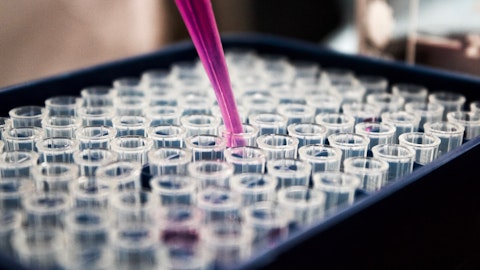And really demonstrate to them, how we can conquer these challenges that haven’t been conquered by more traditional methods. And so with those particular groups, we decided to stop with the outreach with just those for particular groups and not further specifically so that we could continue to optimize our algorithms so that we could adjust if we saw any areas that we felt needed improvement, and so that we could utilize all of the sequence information coming in from those programs to also feed our algorithm as our AI would enable it to continue to collect statistical data and improve. We anticipate that it’s probably two to three months before we go out with data. And again, it really depends on how these programs go from a timeline perspective and a quality perspective.
But to be able to start using some of that data to go out and, and share with other groups, probably again for several months on a face-to-face, one-on-one offering with various groups. And I would anticipate and again there’s caveats there that make it difficult to exactly pinpoint, but not until we’ve had a total of five or six successful programs through there that we would open this up on mass to larger offerings. That being said, the offerings that we’ve gone out through but right now for these four groups are two smaller biotech and two very large more like Top 10 pharmaceutical companies. And what we anticipate and what’s also been indicated by those larger companies is if we were successful with these programs for them, they would likely be interested in taking on larger target deals to use up the capacity that this available at BioStrand with a larger upfront payment?
So whether it’s more companies or just more programs, well, we’ll have to see. The overall timeline for that if we had to put an estimate on it is probably around eight months.
Michael Freeman: Okay. That’s extremely helpful. And I’m glad you provided that detail of two small biotechs and two large biopharmas, I guess. I get, and this is rolled nicely into my next question. We were glad to see that that you were able to publicly announce like the name of your health department that you’re working with BriaCell. We recognize that you are partnered with a high quality group of partners through the CRO €“ the historical CRO business and your other businesses. Do you expect you will be able to announce the names of partners that you work with and in the future this is helpful to understand the pedigree of groups that are attracted to the offerings we have today?
Jennifer Bath: Yes. Great question. So right now as a part of the early adopter program, it is actually a requirement that we have written into the four different standard agreement options. So right now we do have approval from those groups and the three remaining groups that if those agreements go through, we would be able to share their name publicly. There is one time consideration for one of those groups who said we are currently working on something that’s very important that would suggest that maybe not releasing our name right away would be pertinent, but that timeframe is possibly one to two months out. So if that deal closes prior to that particular significant event changing for them then we would make the announcement without the name and then follow up on the first event with that program with a name.
On the contrary if their personal big event for them occurred prior to signing the agreement, we would be able to announce it. So short answer is that yes it’s been written in definitely for the 75%, three of the four, the name will be out there in the initial announcement for one it may trail slightly.
Michael Freeman: Fantastic. Well we’ll watch the newswire to see those names announce. Thank you very much for taking my questions. I’ll hand that.
Jennifer Bath: Thank you.
Operator: Your next question will come from the line of Will McHale with Ingalls & Snyder. Please go ahead.
Will McHale: Good morning, Jen and team and thanks for taking my question. I’m delighted to see the progress at BioStrand so far with partnership agreements. I was hoping you could explain what specifically about the technology is resonating the most in discussions and how it might be different differentiated from other offerings out there.
Jennifer Bath: Sure, and hi Will. Great to hear from you. But yes, I’d be happy to explain that. So as I mentioned a minute ago, we had offered these to four different companies from smaller well funded biotechs to Top 10 pharma. Participating in this early adopter program and during the due diligence process what really became evident for these companies going into due diligence especially the larger ones was really what was kind of driving their excitement around these particular programs and why they came to us in general. And one of the more common themes here is the potential for LENSai software to analyze and solve these very complex programs that couldn’t be achieved with those traditional laboratory settings. And in addition to that, we saw a number of programs that reflected therapies that these groups have been working on for close to a decade that never had a success.
